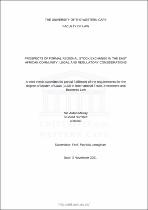| dc.description.abstract | The East African Community (EAC) is among the eight regional economic
communities recognised under the platform of the African Union.1 What has
transformed to become the EAC was initially founded in 1967 with the name East
African Co-operation, having Kenya, the United Republic of Tanzania and Uganda
as members states.2 The Treaty establishing the East African Cooperation was
subsequently dissolved in 1977 owing to various reasons, including the perceived
dominance of Kenya, misunderstandings on resource sharing and ideological
differences of the three-member states.3
The Treaty for the Establishment of the East African Community of 1999
(henceforth called the EAC Treaty) signed by Kenya, Uganda, and the United
Republic of Tanzania revived the EAC as we have it today.4 These founding
member states signed the EAC Treaty on 30 November 1999, and it entered into
force on 7 July 2000.5 In July 2007, Rwanda and Burundi joined the EAC.6 The
Republic of South Sudan became the last country to join the EAC in April 2016,7
thereby bringing the total number of member states to the EAC Treaty to six. | en_US |

